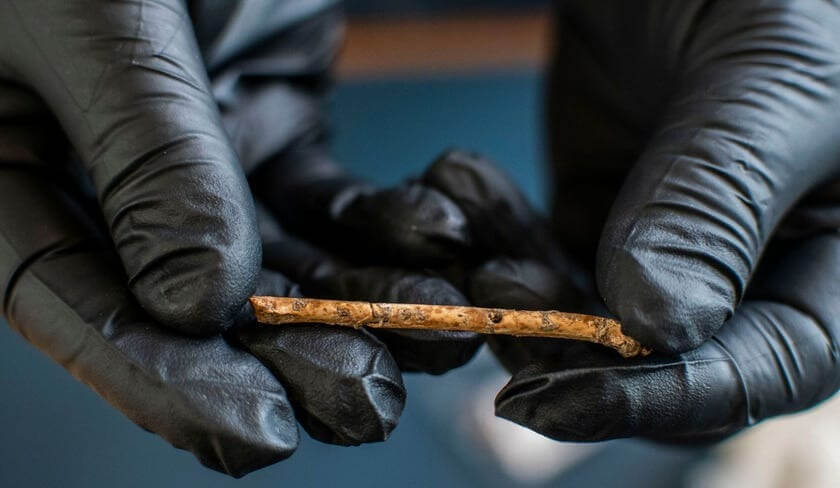12,000-year-old flutes found in Israel may be earliest bird-call whistles in the world
Israeli archaeologists find seven tiny whistles made of bone that emit sounds like calls of predatory birds at prehistoric swamp site in the Hula Valley

One of the seven miniature bone flutes found in Hula Valley from over 12,000 years ago. Photo by Yoli Schwartz/Israel Antiquities Authority
This article originally appeared on Haaretz, and was reprinted here with permission. Sign up here to get Haaretz’s free Daily Brief newsletter delivered to your inbox.
Over 12,000 years ago, prehistoric people in northern Israel may have invented the duck call.
Seven tiny, fragile wing-bones discovered at a prehistoric site in northern Israel turn out to have been perforated. They may have served as whistles imitating the calls of predatory birds, Israeli archaeologists reported Friday in Nature Scientific Reports.
Or maybe they were very tiny musical instruments; or used to communicate with birds; or for another purpose we cannot fathom. In any case, replicas of the ancient artifacts produced sounds similar to the calls of sparrowhawks and kestrels, say the authors, Dr. Lauren Davin of the Hebrew University of Jerusalem and French Research Center of Jerusalem, Dr. José-Miguel Tejero of Vienna University and Barcelona University, Dana Shaham of the Hebrew University, Dr. Hamoudi Khalaily of the Israel Antiquities Authority and colleagues.
One of the flutes was discovered complete, the team says.
They could have been imitating bird calls in order to attract them, as duck hunters do to this day. Today some hunters preen in their ability to imitate a duck while others resort to industrially made “duck call” whistles.
Does duck calling actually work, though? “A realistic duck call can lure ducks close enough for hunters to take ethical shots,” claims one purveyor of presumably realistic devices. Sometimes, if anything, they reportedly seem to repel the birds in droves.
“If the flutes were used for hunting, then this is the earliest evidence of the use of sound in hunting,” Khalaily says. It’s almost a miracle that these instruments survived the ages – one would expect mini-flutes made of teeny bird bones to deteriorate and vanish, but these didn’t and were found while flushing with water the finds from the excavation of Eynan, a prehistoric settlement in the Hula Valley, a once swampy area north of the Sea of Galilee.
Eynan is associated with a Late Stone Age culture, the Natufians, pre-agricultural groups living in Israel and the surrounding region from 15,000 to about 11,700 years ago. They were hunter-gatherers but were among the earliest people to settle down, building the first known stone homes in the region. They also created giant stone “boulder” mortars whose use remains a mystery, may have had shamans, did have dogs, and buried their dead with ceremony.
Excavations at Eynan began in 1955, by a French mission, and continued later from 1996 to 2005 by a joint team from the CRJF and the IAA, directed by François Valla of the Centre Nationale de Recherche Scientifique (CNRS) and Khalaily. In various digs, the archaeologists found the remains of five circular stone homes and a plethora of animal bones, including birds – over 1,100 bird bones. Most turn out to have belonged to migratory waterfowl.
The new paper reports on recent analysis of the material culture and grave goods previously found at Eynan; and while studying some of the bird bones found at the site, Davin noticed marks on seven tiny wing bones of Eurasian coots and Eurasian teals.
The realization arose that the marks were very tiny perforations – holes bored into the fragile, narrow bird bones. So the bones had been worked, they were artifacts.
Together with scientists at the CNRS, Aurelia Bourbon and Olivier Tourny, replicas were made and while experimenting with them – they discovered that blowing into them produced sounds. They were miniature flutes of some kind, it seems.
Shoring up their contention that the holes were drilled deliberately and not made by the teeth of a swamp cat or other hungry predator, the team closely analyzed how the perforations interpreted as finger-holes were made. The answer is “meticulously,” by transverse and oblique micro-grooving with a flint tool. “The grooving is precise and was obtained by movements alternatively from the right and left edges, reorienting the bone blank several times,” they explain – and the result is holes that can be sealed by the fingertip, a must for wind instruments.
Comparing the sounds made by the replicas with the calls of dozens of bird species plying the Hula Valley, they realized the sounds were like the calls of birds of prey: the Eurasian sparrowhawk and the Common kestrel. Nothing like that has even been found in the Paleolithic archaeological record, the archaeologists say.
Why would the Natufians want to reproduce the calls of predators? Even if the context was hunting, two possibilities come to mind. One is to flush other, more toothsome birds out of the swamp and vegetation of the valley. By this theory, when they blew the whistle, other waterfowl afraid of the predatory sparrowhawk and the kestrel would take fright and beetle off, and could be shot down with bow and arrow or however they hunted birds.
Note that according to Prof. Tal Simmons of Virginia Commonwealth University, most of the bird bones they identified belonged to migratory birds: waterfowl who winter in Israel.
Another possibility is that the raptors would be attracted to the calls and could then be shot and eaten themselves. Also, going back hundreds of thousands of years, humans and their predecessors seem to have had a fetish for raptor talons and feathers; and their bones could be used too, to produce more bird-call whistles.
The discovery of musical instruments from the deep past is rare, and controversial. One famous example is the “Neanderthal bone flute” with holes that some researchers believe were instead made by hungry hyenas.
The postulated whistles add to other evidence of sound-making in the Natufian, says Dana Shaham of the Hebrew University. For instance, possible instruments include a “belt” of bone pendants that may have served as rattles, bone objects interpreted as bullroarers (aka tundruns – an instrument that makes load roaring noises that can be heard over great distances), and as for those strange mortars, some carved into the very bedrock of Israel, there is a theory that pounding them would make a drumming sound that could be used, for instance, to call the clan to convene. And if they did, they could possibly have whistled down some birds to eat in happy community.
The Forward is free to read, but it isn’t free to produce

I hope you appreciated this article. Before you go, I’d like to ask you to please support the Forward.
Now more than ever, American Jews need independent news they can trust, with reporting driven by truth, not ideology. We serve you, not any ideological agenda.
At a time when other newsrooms are closing or cutting back, the Forward has removed its paywall and invested additional resources to report on the ground from Israel and around the U.S. on the impact of the war, rising antisemitism and polarized discourse.
This is a great time to support independent Jewish journalism you rely on. Make a gift today!
— Rachel Fishman Feddersen, Publisher and CEO
Support our mission to tell the Jewish story fully and fairly.
Most Popular
- 1

Culture Cardinals are Catholic, not Jewish — so why do they all wear yarmulkes?
- 2

Fast Forward Ye debuts ‘Heil Hitler’ music video that includes a sample of a Hitler speech
- 3

News School Israel trip turns ‘terrifying’ for LA students attacked by Israeli teens
- 4

Fast Forward Student suspended for ‘F— the Jews’ video defends himself on antisemitic podcast
In Case You Missed It
-

Yiddish קאָנצערט לכּבֿוד דעם ייִדישן שרײַבער און רעדאַקטאָר באָריס סאַנדלערConcert honoring Yiddish writer and editor Boris Sandler
דער בעל־שׂימחה האָט יאָרן לאַנג געדינט ווי דער רעדאַקטאָר פֿונעם ייִדישן פֿאָרווערטס.
-

Fast Forward Trump’s new pick for surgeon general blames the Nazis for pesticides on our food
-

Fast Forward Jewish feud over Trump escalates with open letter in The New York Times
-

Fast Forward First American pope, Leo XIV, studied under a leader in Jewish-Catholic relations
-
Shop the Forward Store
100% of profits support our journalism
Republish This Story
Please read before republishing
We’re happy to make this story available to republish for free, unless it originated with JTA, Haaretz or another publication (as indicated on the article) and as long as you follow our guidelines.
You must comply with the following:
- Credit the Forward
- Retain our pixel
- Preserve our canonical link in Google search
- Add a noindex tag in Google search
See our full guidelines for more information, and this guide for detail about canonical URLs.
To republish, copy the HTML by clicking on the yellow button to the right; it includes our tracking pixel, all paragraph styles and hyperlinks, the author byline and credit to the Forward. It does not include images; to avoid copyright violations, you must add them manually, following our guidelines. Please email us at [email protected], subject line “republish,” with any questions or to let us know what stories you’re picking up.











